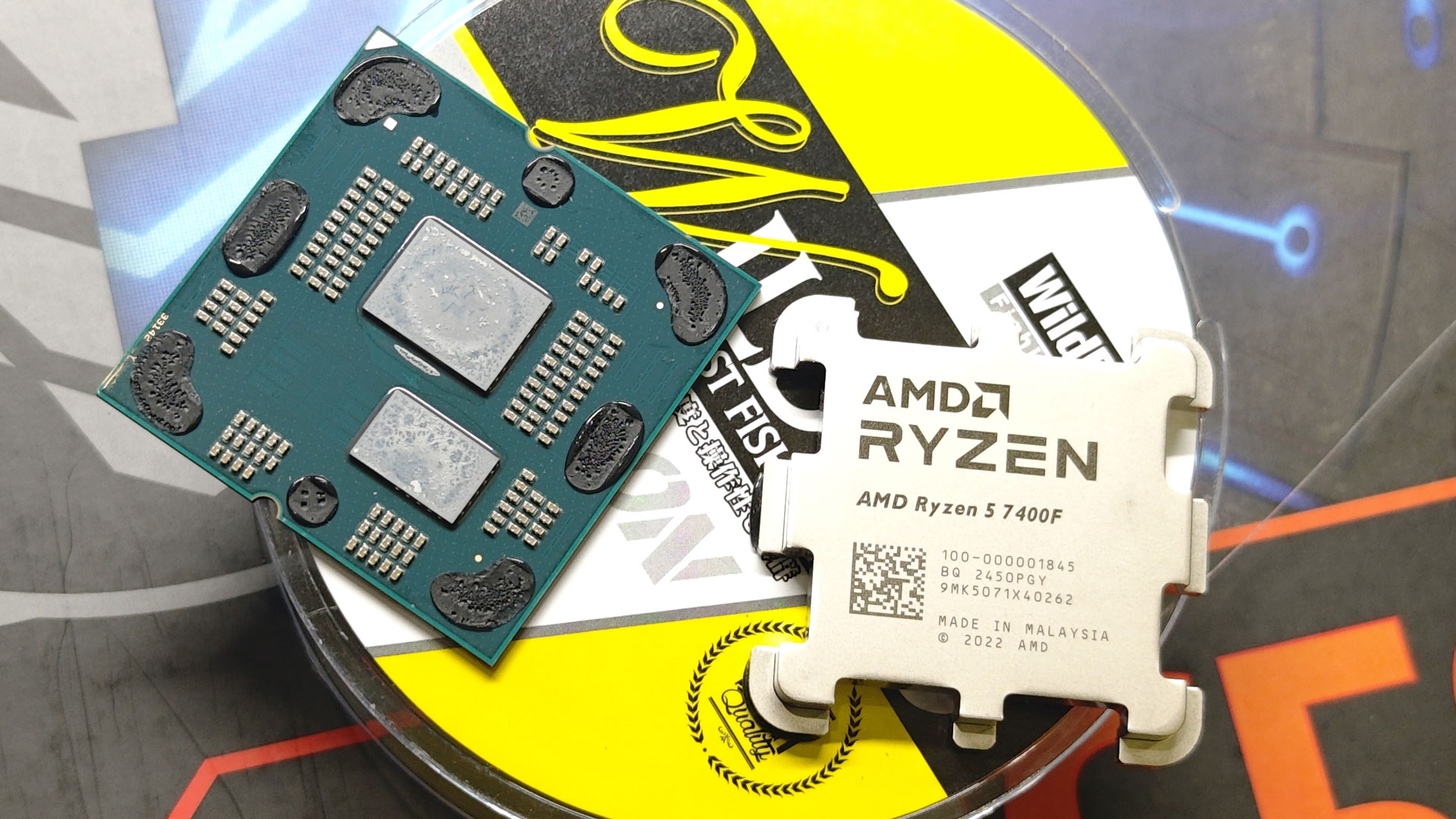Ryzen 5 7400F uses thermal paste instead of solder, chip hits max temps at stock TDP
At least it's affordable.

A user review of the Ryzen 5 7400F at Bilibili suggests performance similar to the 7500F with superior binning, at least when the processor is not thermally constrained (via Harukaze at X). Further inspection by delidding the CPU reveals that AMD has opted for simple thermal paste instead of Solder Thermal Interface Material (STIM) between the Integrated Heat Spreader (IHS) and the CPU die, likely as a cost-saving measure. With a low price tag of just $115 (in China), AMD had to cut corners somewhere and it seems we've found the answer.
To recap, last month AMD silently released the hexacore Ryzen 5 7400F, standing as the most affordable Raphael-based CPU for consumers. What separates the 7400F from the 7500F is inferior binning as reflected in the clock-speeds. The Ryzen 5 7400F offers six cores and twelve threads based on AMD's Zen 4 architecture. Employing Raphael silicon underneath nets it 32MB of L3 cache and 6MB of L2 cache, with a base TDP of 65W (88W PPT). In terms of clock speeds, the 7400F is advertised with a base frequency of 3.7 GHz, reaching as high as 4.7 GHz, 300 MHz slower than the 7500F.
The reviewer's test bench features the Ryzen 5 7400F paired with DDR5-6000 CL36 memory on MSI's MPG 850 Edge Ti WiFi motherboard. The Bilibili-based reviewer specified two AIOs for the test namely: the Taiyu T360 Pro and the DeepCool LP360. With all settings at default and only EXPO enabled, the Ryzen 5 7400F falls 6% short of the 7500F in the Cinebench R23 single-core benchmark.
At the default 88W PPT, the 7400F easily hits Tjmax (95 degrees Celsius) with a liquid cooler, a direct consequence of the inferior interface material. When the package power is lifted to around 100W, the CPU hits 105 degrees Celsius and promptly shuts down. After manually adjusting the voltage and frequency in the BIOS, the 7400F clocked at 5.05 GHz with a temperature of 96 degrees Celsius.
The reviewer didn't test the 7400F with PBO, but you'd probably have to spend more time fine-tuning the offsets to hit 5 GHz at comfortable temperatures. STIM has several advantages for CPUs as it's not only more thermally conductive but also lasts longer than normal thermal grease. Again, this has no perceivable impact on the average consumer who doesn't have the time or isn't interested in overclocking. For enthusiasts or even budget gamers looking to get the most out of their processor, the Ryzen 5 7500F should still be the superior choice.
Stay On the Cutting Edge: Get the Tom's Hardware Newsletter
Get Tom's Hardware's best news and in-depth reviews, straight to your inbox.

Hassam Nasir is a die-hard hardware enthusiast with years of experience as a tech editor and writer, focusing on detailed CPU comparisons and general hardware news. When he’s not working, you’ll find him bending tubes for his ever-evolving custom water-loop gaming rig or benchmarking the latest CPUs and GPUs just for fun.
-
rluker5 Sounds a lot like my old 4770k before I delidded it. But I did have to delid it to get it to 5Ghz.Reply -
teeejay94 This is a really good way to ruin all the momentum they've built up recently and destroy people's trust. Of course this won't be the tipping point of that, but continue on this path AMD and don't say I didn't warn you.Reply -
m3city Reply
Really? That is a budget cpu and will run exactly as advertised with a stock air cooler under general loads.teeejay94 said:This is a really good way to ruin all the momentum they've built up recently and destroy people's trust. Of course this won't be the tipping point of that, but continue on this path AMD and don't say I didn't warn you. -
Amdlova Reply
Your warnings it's like a children at play ground crying.teeejay94 said:This is a really good way to ruin all the momentum they've built up recently and destroy people's trust. Of course this won't be the tipping point of that, but continue on this path AMD and don't say I didn't warn you.
That is a defective cheap cpu for who don't care of speed. Just want it to work without dropping more money into it. -
DRagor Reply"STIM has several advantages for CPUs as it's not only more thermally conductive but also lasts longer than normal thermal grease. Again, this has no perceivable impact on the average consumer"
Isn't that direct contradiction? If chip with thermal paste will last shorter then one with STIM then it DOES affect average consumer quite a lot. -
pointa2b As long as this thinking doesn't permeate into their mid-higher range CPUs, whatever corners they're cutting to make a budget Zen 4 CPU isn't important to me.Reply -
hotaru251 Reply
you mean people who whine that theres no low end amd cpu's who finally got one that is able to hit every claim of the chip just lacks OC headroom???teeejay94 said:This is a really good way to ruin all the momentum they've built up recently and destroy people's trust
if you are buying a this low end of a cpu you won't have issues. -
NeonHD Extremely petty and unrelated, but I'm glad this was sourced on bilibili and not stinkin' reddit.Reply -
DingusDog On the bright side at least it makes delidding easier, which no one will do because it's pointless.Reply -
greenreaper Another path to value is to get the 7600, then do without a separate GPU. Sure, it's only 2 CU, but it has all the features of RDNA 2, including the media block. Enthusiasts can undervolt and overclock both CPU and iGPU.Reply